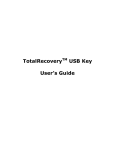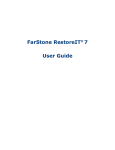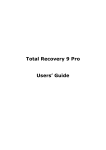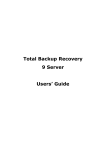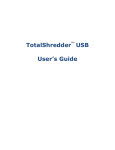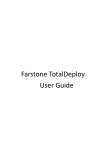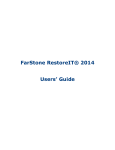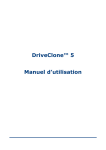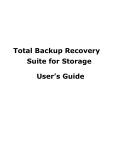Download TotalRecovery Express User's Guide
Transcript
TM TotalRecovery Express User’s Guide Copyright Notice No part of this publication may be copied, transmitted, stored in a retrieval system or translated into any language in any form or by any means without the expressed written permission of FarStone Technology, Inc. FarStone grants you the right to use one copy of the enclosed software program (“SOFTWARE”) on a single computer. If the SOFTWARE is installed on a network, or more than one user can run the SOFTWARE at the same time, you must purchase an additional license for each additional user or computer. Trademark FarStone® is a trademark of FarStone Technology, Inc. Microsoft, Windows® and MS-DOS® are registered trademarks of Microsoft Corporation. Other product names mentioned in this User’s Guide may be trademarks or registered trademarks of their respective companies. FarStone Technology, Inc. U.S. Headquarters: 1758-B North Shoreline Blvd Mountain View, CA 94043 Phone: (650)969-4567 Fax: (650)968-4567 www.farstone.com Asia-Pacific Offices 9F-4, No.87, Sec 4 Jhongsiao E. Rd. Taipei City 106,Taiwan Phone: 886-2-2777-2887 Fax: 886-2-2777-2857 www.farstone.com.tw Technical Support Answers to frequently asked questions are posted on our website at www.farstone.com/support/faqs. For other support issues, please contact FarStone Technical Support at www.farstone.com/support. Copyright© 2000-2010 FarStone Technology, Inc. All rights reserved. Software License Agreement FARSTONE TECHNOLOGY, INC. (FARSTONE) END USER LICENSE AGREEMENT TOTALRECOVERYTM EXPRESS, HEREAFTER REFERRED TO AS THE “SOFTWARE” FOR PLEASE READ CAREFULLY: THE USE OF THIS “SOFTWARE” IS SUBJECT TO THE “SOFTWARE” LICENSE TERMS OF FARSTONE AND OTHER LICENSORS WHO’S SOFTWARE MAY BE BUNDLED WITH THIS PRODUCT. BY YOUR USE OF THE “SOFTWARE” INCLUDED WITH THIS PRODUCT YOU AGREE TO THE LICENSE TERMS REQUIRED BY THE LICENSOR OF THE “SOFTWARE”, AS SET FORTH BELOW. IF YOU DO NOT AGREE TO THE LICENSE TERMS APPLICABLE TO THE “SOFTWARE”, YOU MAY RETURN THE ENTIRE UNUSED PRODUCT FOR A FULL REFUND. LICENSE AND WARRANTY: The software that accompanies this license (the “Software”) is the property of FARSTONE or its licensors and is protected by copyright law. While FARSTONE continues to own the Software, you will have certain rights to use the Software after your acceptance of this license. Except as may be modified by a license addendum which accompanies this license, your rights and obligations with respect to the use of this Software are as follows: A. Single User License: (a) Use the “Software” on a single computer system or network, and only by a single user at a time. If you wish to use the “Software” for more users, you will need an additional License for each user. (b) Make one copy of the “Software” in machine-readable form solely for back-up purposes provided you reproduce FarStone’s copyright proprietary legends. Notwithstanding the foregoing, the “Software” may be used on the home, laptop or other secondary computer of the principal user of the “Software”, and an additional copy of the “Software” may be made to support such use. As used in this License, the “Software” is “in use” when it is either loaded into RAM or installed on a hard disk or other permanent memory device. The “Software” may be “in use” on only one computer at any given time. (Different License terms and fees are applicable for networked or multiple user applications.) As a specific condition of this License, you agree to use the “Software” in compliance with all applicable laws, including copyright laws, and that you will not copy, transmit, perform or distribute any audio or other content using the “Software” without obtaining all necessary Licenses or permissions from the owner of the content. B. Multiple User License: Make one copy of the “Software” in machine-readable form solely for back-up purposes, provided you reproduce FarStone’s copyright proprietary legends. You must acquire and dedicate a License for each separate computer on which any part or portion of the “Software” is installed or run As used in this License, the “Software” or any part or portion of the “Software” is “in use” when it is either loaded into RAM or installed on a hard disk or other permanent memory device including any networked or shared environment where either direct or indirect connections are made through software or hardware which pools or aggregates connections. As a specific condition of this License, you agree to use the “Software” in compliance with all applicable laws, including copyright laws, and that you will not copy, transmit, perform or distribute any audio or other content using the “Software” without obtaining all necessary Licenses or permissions from the owner of the content. C. Restrictions: You may not distribute copies of the “Software” to others or electronically transfer the “Software” from one computer to another over a network. You may not post or otherwise make available the “Software”, or any portion thereof, in any form, on the Internet. You may not use the “Software” in a computer service business, including in time-sharing applications. The “Software” contains trade secrets and, in order to protect them, you may not decompile, reverse engineer, disassemble, or otherwise reduce the “Software” to a human-perceivable form. YOU MAY NOT MODIFY, ADAPT, TRANSLATE, RENT, LEASE, LOAN, RESELL FOR PROFIT, DISTRIBUTE, NETWORK OR CREATE DERIVATIVE WORKS BASED UPON THE “SOFTWARE” OR ANY PART THEREOF. D. Limited Warranty: FarStone warrants that the media on which the Software is distributed will be free from defects for a period of fourteen (14) days from the date of delivery of the Software to you. Your sole remedy in the event of a breach of this warranty will be that FarStone will, at its option, replace any defective media returned to FarStone within the warranty period or refund the money you paid for the Software. FarStone does not warrant that the Software will meet your requirements or that operation of the Software will be uninterrupted or that the Software will be error-free. THE ABOVE WARRANTY IS EXCLUSIVE AND IN LIEU OF ALL OTHER WARRANTIES, WHETHER EXPRESS OR IMPLIED, INCLUDING THE IMPLIED WARRANTIES OF MERCHANTABILITY, FITNESS FOR A PARTICULAR PURPOSE AND NONINFRINGEMENT. THIS WARRANTY GIVES YOU SPECIFIC LEGAL RIGHTS. YOU MAY HAVE OTHER RIGHTS, WHICH VARY FROM STATE TO STATE. E. Limitation of Liability: IN NO EVENT WILL FARSTONE OR ITS LICENSORS BE LIABLE TO YOU FOR ANY INCIDENTAL, CONSEQUENTIAL OR INDIRECT DAMAGES, INCLUDING ANY LOST PROFITS, LOST SAVINGS, OR LOSS OF DATA, EVEN IF FARSTONE OR A LICENSOR HAS BEEN ADVISED OF THE POSSIBILITY OF SUCH DAMAGES, OR FOR ANY CLAIM BY ANY OTHER PARTY. Some states do not allow the exclusion or limitation of special, incidental, or consequential damages, so the above limitation or exclusion may not apply to you. F. General: You acknowledge that you have read this Agreement, understand it, and that by using the “Software” you agree to be bound by its terms and conditions. You further agree that it is the complete and exclusive statement of the agreement between FarStone and you, and supersedes any proposal or prior agreement, oral or written, and any other communication between FarStone and you relating to the subject matter of this Agreement. No additional or any different terms will be enforceable against FarStone unless FarStone gives its express consent, including an express waiver of the terms of this Agreement, in writing signed by an officer of FarStone. You assume full responsibility for the use of the “Software” and agree to use the “Software” legally and responsibly. Should any provision of this Agreement be declared unenforceable in any jurisdiction, and then such provision shall be deemed severable from this Agreement and shall not affect the remainder hereof. FarStone reserves all rights in the “Software” not specifically granted in this Agreement. Additional Terms and Conditions: In addition to the above agreement, the following terms and conditions will also apply to Your use of the Software: A. You may use the Software on one Device to clone, or apply an image of a hard drive on that Device, or to another hard drive on the same Device, a replacement Device, secondary media, or network drive. B. You may use the Software on a Device to create an image file of a hard drive on that Device and store the image file on fixed or removable media for disaster recovery purposes. C. You may use the Software as a boot disk to re-apply the hard drive image that was created for disaster recovery purposes to the hard drive on the Device from which the disaster recovery image was made or on a replacement Device provided that the software has been removed from the original Device. D. You may use the Software to clone a hard drive from a Device to a replacement Device, in the manner described in the Software documentation and to use the Software on the replacement Device provided that the Software has been removed from the original Device. E. You may not use the Software commercially or non-commercially for the purpose of creating an image on multiple Devices or hard drives, except for multiple hard drives installed in or attached directly to the original Device. F. For the purposes of this License Agreement, a virtual device is considered the same as a physical device. G. If the Software you have licensed includes the Pre-OS the following uses and restrictions apply to the Software: (i) The Pre-OS contains Windows® software licensed from Microsoft Corporation. Microsoft Corporation has no liability to You for the Component. Any support for the Component will be provided by FarStone in accordance with FarStone’s then-current support guidelines. (ii) THE PRE-OS CONTAINS A TIME-OUT FEATURE THAT WILL AUTOMATICALLY RE-BOOT THE DEVICE AFTER SEVENTY-TWO HOURS OF CONTINUOUS USE. THIS TIME-OUT FEATURE WILL RESET EACH TIME THE COMPONENT IS RE-LAUNCHED. (iii) The Pre-OS may be used as a boot, diagnostic, disaster recovery, setup, restoration, emergency service, installation, test, and configuration utility program. Use of the Component as a general purpose operating system or as a substitute for a fully functional version of any operating system product is strictly prohibited. Windows® is a registered trademark of Microsoft Corporation. Should you have any questions concerning this Agreement, you may contact FarStone by writing to: FarStone Technology, Inc. 1758-B North Shoreline Blvd Mountain View, CA 94043 Contents Chapter 1: Introduction ........................................................................................................................ 8 1.1 Product Overview............................................................................................................................................ 8 1.2 Features and Benefits...................................................................................................................................... 8 1.3 System Requirements ..................................................................................................................................... 9 Chapter 2: Start using TotalRecoveryTM Express.................................................................................11 2.1 Main Console ................................................................................................................................................ 11 2.1.1 Create Bootable USB Drive......................................................................................................................... 11 2.1.2 Create Start‐up CD/DVD Disc ..................................................................................................................... 12 2.1.3 Extract ISO File for Windows/Linux ........................................................................................................... 12 Chapter 3: Use TotalRecoveryTM Express ...........................................................................................14 3.1 Enter TotalRecoveryTM Express................................................................................................................... 14 3.1.1 Boot via Start‐up CD/DVD Disc .................................................................................................................. 14 3.1.2 Boot via Bootable USB Disk........................................................................................................................ 14 3.2 TotalRecoveryTM Express Main Console ..................................................................................................... 15 3.2.1 Quick Start ................................................................................................................................................. 15 3.2.2 Back Up and Restore My Computer ........................................................................................................... 15 3.2.3 Clone Tab ................................................................................................................................................... 18 3.2.4 Data Shredding Tab.................................................................................................................................... 20 3.2.5 Analyze Tab ................................................................................................................................................ 21 3.2.6 Network Tab............................................................................................................................................... 22 3.2.7 Tools Tab ..................................................................................................................................................... 25 Chapter 4: Glossary .............................................................................................................................27 Chapter 5: Appendix............................................................................................................................29 5.1 Frequently Asked Questions.......................................................................................................................... 29 Chapter 1: Introduction 1.1 Product Overview TotalRecoveryTM Express is a hard drive utility that backs up or clones hard drives or partitions. It creates a compressed archive file that contains all files, partition information and security information stored on a hard drive or CD/DVD. TotalRecoveryTM Express can be used for various purposes. PC users can use TotalRecoveryTM Express as a quick and easy way to back up and restore their data in the event of a system crash. System administrators can use it to dramatically reduce the time they spend restoring, reconfiguring or copying data onto the hard drives of many computers. Whether you need to back up, recover, protect or upgrade PCs, TotalRecoveryTM Express is an all-in-one solution. 1.2 Features and Benefits Complete Backup Make a complete copy of your hard drive, including system settings, partition information, documents, photos and more; save it as a compressed image file. If you suffer a system or disk crash, virus attack or other failure, you can restore the entire system disk in minutes. Clone Drives Make a complete copy of your hard drive including system settings and partition information. Data Shredding - US DoD 5220.22-M Standard Complied Complies with the US DeparTMent of Defense (DoD) 5220.22-M clearing standard. Securely wipe out your hard drive contents from outside of Windows. RAID Support Supports most 0/1/5/10 hardware and software RAIDs. Win-PE engine 100% compatible with existing hardware and future hardware. Powerful Universal Restore Restore files or images across different hard drives regardless of hard drive format, size, brand, 8 or operating system; or clone your computer to a new hard drive. Pre-Windows Recovery TotalRecoveryTM Express works even when your operating system doesn't, allowing you to restore your system regardless of OS functionality. Image Integrity Verification Automatically ensures that backup images work properly. Complete External Backup Enables you to store your hard disk image on a USB hard drive. CD/DVD Support Use the built-in burner to save a copy of your hard drive on a CD or DVD Bare Metal Restore Copy a complete system image onto a brand new hard drive without needing to install an operating system first. Partition Support TotalRecoveryTM Express supports FAT32, NTFS, Linux EXT2/3 and other unknown partitions. 1.3 System Requirements Storage Media The following storage locations are supported: • Hard Disk Drives • Networked Attached Storages (NAS) • Network Share Folders • CD-R/RW, DVD-R/RW, DVD+R/RW • USB Hard Drives and Storages 9 • PATA (IDE), SATA, SCSI, IEEE1394 (FireWire), USB 1/2.0 drives, ESATA and PC-Card storage devices Supported Operating Systems • Windows Vista Series(32-bit & x64) • Windows 2008 Series(32-bit & x64) • Windows XP Series(32-bit & x64) • Windows 2003 Series(32-bit & x64) • Windows 2000 Series(32-bit & x64) • Linux • Unix • CPU: Pentium-class processor or higher • RAM: 512 MB • Disk space: No installation required Supported File Systems • FAT16/32, NTFS, Linux Ext2/Ext3, ReiserFS, Linux Swap and other unknown partitions. 10 Chapter 2: Start using TotalRecoveryTM Express To launch the TotalRecoveryTM Express Main Console: 1. Double-click the TotalRecoveryTM Express icon. 2. Enter your serial number, and click OK to continue. 2.1 Main Console 2.1.1 Create Bootable USB Drive Create a bootable disk of TotalRecoveryTM Express to recover from a system crash or hard drive failure. 11 1. Insert a USB device. 2. Click Bootable USB Disk on the main console. 3. Select the USB device you’ll be using to create your Bootable Disk and click Start. 4. Click Finish to complete the process. 5. You will need to enter the BIOS to set the USB disc as the first boot device. 2.1.2 Create Start-up CD/DVD Disc Use this disc to restore your system within TotalRecoveryTM Express if a system crash occurs. 1. Insert a writable CD/DVD disc. 2. Click Create a Start-up CD/DVD Disc. 3. Select a CD/DVD writer. 4. Click Start to burn the image onto the disc. 5. Click Finish to complete the process and return to Main Console. 6. In order to use TotalRecoveryTM Express, you will need to enter the BIOS to set CDROM as the first boot device. 2.1.3 Extract ISO File for Windows/Linux Create and store the ISO file on a specified location such as a local hard drive, removable storage device, or network storage device. 1. Click Extract ISO File. 2. Specify a location and click Goto, or select a location and click Start to store the ISO file. 12 Tip 1. If you want to store the ISO file onto CD/DVD disc, you can use a third party software to burn the ISO file onto CD/DVD disc. 2. The CD/DVD disc which contain the ISO file can be used as a Start-up Disc to launch TotalRecoveryTM Express Pre-OS mode to restore your computer. 3. If you select a location on the network, you may be prompted to provide a username and password. If your system does not respond when you try to save the ISO file to a network location, please contact your network administrator to check your connection status and access privileges. 3. Click Finish to complete the process and return to Main Console. 13 Chapter 3: Use TotalRecoveryTM Express 3.1 Enter TotalRecoveryTM Express 3.1.1 Boot via Start-up CD/DVD Disc To use TotalRecoveryTM Express with a Start-up CD/DVD Disc: Insert the Start-up Disc and restart your computer, and then enter the BIOS to set the CD/DVD ROM as the first boot device. 3.1.2 Boot via Bootable USB Disk To launch TotalRecoveryTM Express with Bootable USB Disk: 1. Connect the USB device, start your computer, enter the BIOS to set the USB device as the first bootable option, and save your settings. 2. Restart the system and boot from the USB device. 3. Click Yes to back up the entire system to the USB device automatically. Or click No to enter TotalRecoveryTM Express main console. 4. Verify all information about this complete backup, and then click Next to launch it. 5. Click Finish to complete the backup and return to main console. 14 3.2 TotalRecoveryTM Express Main Console 3.2.1 Quick Start Back Up My Computer – Click here to back up partition(s) or the entire hard drive for your system. Restore Your Computer – Click here to restore from a complete backup point. Data Shredding (Eradication) US Department of Defense Standard Complied – Click here to erase all data on a specified partition or the entire hard drive. 3.2.2 Back Up and Restore My Computer 3.2.2.1 Back up My Computer 1. Click on Back Up Computer(s) on the main console. 15 2. Enter a name for your new Complete Backup and click Next. 3. Select partition(s) or the entire hard disk to back up, and click Next. Tip 1.If there is only one partition in a disk, select the partition and the program will select the disk automatically. 2. If there is only one disk, select the disk and the program will select the partition automatically. 4.Enter the storage path and click Goto. Or select a destination location on a hard drive, USB storage medium, or a network location to store the image file. Some optional settings will display if you click Advanced, including compression mode, password protection, image split, integrity check, backup description, backup priority, and network connection speed. 5. Click Next. 6. Review the information and settings that have been specified. Click Next to launch the backup process. Or click Back to modify setting(s). 7. Click Finish to return to main console. 3.2.2.2 Restore Your Computer To restore a partition or the entire hard drive, please do the following: 1. Enter into TotalRecoveryTM Express main console. 2. Click on Restore Your Computer. 3. Select a backup image from the list and click Next to continue. If the backup image you want to use is not listed, you will be prompted to search for the image by clicking Browse. 16 4. Choose whether you’d like to restore a single partition or the entire hard drive, and click Next. 5. Select a destination partition or a destination hard drive to be restored from the image file, and click Next. If you choose to restore a single partition, click Yes to launch the restoration process. 6. To restore the entire hard disk, please select a restore option. a. Select the checkbox to modify the destination partition size. b. Don’t select it for fear of information loss on multiple systems or hidden partition. If you selected option a, double click the partition Capacity to be resized from the list. If you selected option b, skip to step 8. 7. When it shows the structure of the destination partition, double click the highlight and modify its size, and click Next to continue. 8. Click Next to begin the restoration process. 3.2.2.3 Perform Universal Restore To restore the system partition or the entire hard drive of a selected client to dissimilar hardware please do as follows: 1. Launch TotalRecoveryTM Express. 2. Click on Restore Your Computer. 3. Select a backup image from the list and click Next to continue. If the backup image you want to use is not listed, you will be prompted to search for the image by clicking Browse. 4. Select to restore with Universal Restore, and click Next. 5. Select to restore a single partition or the entire hard drive, and click Next. 6. Select a destination partition or a destination hard drive to be restored from the image file, and click Next. If you choose to restore a single partition, click Yes to launch the restoration process. 7. To restore the entire hard disk, please select a restore option. a. Select the checkbox to modify the destination partition size. 17 b.Don’t select it if you have information on multiple systems If you selected option a, double click the partition Capacity to be resized from the list. If you selected option b, skip to step 9. 8. When it shows the structure of the destination partition, double click the highlight and modify its size, and click Next to continue. 9. Click Next to begin the restoration process. 10. Click Next to complete the process. 3.2.3 Clone Tab 3.2.3.1 Clone Drive Clone Drive duplicates one hard drive to another. It eliminates the need to re-install the operating system, drivers and applications, and enables you to upgrade a new hard drive with only a few mouse clicks. To clone a hard drive, please do the following: Tip To use this function; you will need to have at least two hard drives on your computer. The target hard drive should have enough space to store the data of the source hard drive. 1. Select Clone and then click Clone Hard Disk. 2. Select the Source Disk (top pane) and then the Destination Disk (bottom pane). You can choose to modify the Destination Partition Size manually by selecting Modify the destination partition size. You can also choose not to modify the Destination Partition Size by selecting Keep the partition size of the destination drive the same as the source drive. Click Next to continue. Tip If you select Keep the partition size of Destination Hard Disk the 18 same as the Source Hard Drive, please skip to step 4. If the Hard Drive you want to clone is going to boot your system, please select Keep the partition size of Destination Hard Disk the same as the Source Hard Drive. 3. You can alter the Destination Partition size by double-clicking the entry of Destination Partition and change the size in a popup dialog box. Click Next to continue. 4. After confirming your selections, click Clone Now to proceed or you can click Previous to change your selection. If the system is busy, TotalRecoveryTM will try to clone again automatically. Note The cloning process will overwrite all data on the destination disk. Click Continue to begin the cloning process. You can also click Cancel to exit. 5. Click Return to Main Console to complete the process. 3.2.3.2 Clone Partition With TotalRecoveryTM Express, you can copy data from the source partition into the destination partition. To clone a partition, please do the following: 1. Select Clone and then click Clone Partition. 2. Select a Source Partition in the Hard Drive (top pane). Note You can only choose one partition at a time. The Source Partition and the Destination Partition cannot be the same. 3. Select a Destination Partition in the original Hard Drive or another Hard Drive (bottom 19 pane), then click Next to continue. Tip The selected destination partition must have enough space to hold the data of the source partition. 4. After confirming your selections, click Clone Now to start the duplicating process or click Previous to change your selections. You can start the cloning process by clicking Start Clone. If the system is busy, TotalRecoveryTM Express will try to clone again automatically. Tip The cloning process will overwrite all data on the destination disk. Click Continue to begin the cloning process. You can also click Cancel to exit. 5. Click Return to Main Console to complete the process. 3.2.4 Data Shredding Tab TotalRecoveryTM Express can erase all data on the specified partition(s) or the entire hard drive, and the erased data cannot be recovered after eradication. Be cautious before operating this function. 1. Select Data Shredding tab. 2. Select the partition(s) or the entire hard drive and enter the times (maximum of 49) you want to operate eradication. Tip 1.If there is only one partition in a disk, select the partition and the program will select the disk automatically. 2. If there is only one drive, select the drive and the program will select the 20 partition automatically. 3. Confirm all information and then click Start Now. 4. Carefully read the warning message and click OK to continue, or click Cancel to return to main console. 5. Click Finish to return to main console. Tip If the eradication operation is interrupted, the partition and all data on it may be damaged. 3.2.5 Analyze Tab 3.2.5.1 Check Backup Image In this section, you can check if the backup data in your complete backup image file is valid. 1. Select Analyze tab and click on Check Backup Image icon. 2. Enter the storage path of the image you want to check, and click Goto to select the image. You can also select the storage path of the image you want to check and click Next. Tip TotalRecoveryTM Express can also check the image file stored on a mapped drive. For more detail about map network drive, please refer to Configure Network Adaptor. 3. Select to validate either the Complete or Incremental Backup point, and click Next to 21 continue. 4. After validating the backup point, click Finish to complete the Image Integrity Check. 3.2.5.2 Check Hard Drive In this section, you can check if the backup data in your complete backup image file is valid. 1. Select Analyze tab and click on Check Hard Disk for Errors icon. 2. Select the partition to be checked. 3. Do one of the following to launch checking process. a. To check for errors without repairing them, click Check Now without selecting either of the check boxes above. b. To check for and correct system errors, make the appropriate selections in the check boxes. And then click Check Now. 4. Click Finish to return to the main console. 3.2.5.3 Run Command Shell The command shell executes programs and displays their output on the screen by using individual characters. You can use the command shell to create and edit batch files (also called scripts) to automate routine tasks. You can perform operations more efficiently by using batch files than you can by using the user interface. 1. Select Analyze tab and click on Open Command Shell Window icon. 2. Put in the command in the pop-up window and press Enter key. 3. Close the window after the command completes. 3.2.6 Network Tab 22 3.2.6.1 Map Network Drive In this section, you can use the network folder as the local one, and assign a drive letter for it. In doing so, you can access the image files in that folder more conveniently. 1. Select Network tab and click on Map Network Drive icon. 2. Select a drive letter from the drop-down list to map to the shared resource. 3. Enter the computer and share name of the resource in this form: \\Server name\share name. Or click Browse to locate the resource. 4. Click Save. 5. In the User name and password dialog box, type your user name in this form: domain name\username; enter your password if prompted. After the network resource is connected successfully, you can access your data. Note All mapped drive(s) will be removed if you reboot or shut down this computer. 3.2.6.2 Configure Network Adaptor TotalRecoveryTM Express can back up or restore from a network location. To use this feature, you should first configure your network settings. From here, you can configure the IP Address Settings and DNS Server Settings. Click the Network tab and then select Network Adaptor Configuration. Or click the Tools menu and select Settings; you will see the following screen. 23 You can setup your network adaptor, IP address, Subnet mask and Default gateway from here. If you have more than one network adaptor on your system, select the adaptor to be used from the dropdown menu. IP Address Settings: z Obtain an IP address automatically: If your network supports DHCP (Dynamic Host Configuration Protocol), this option will obtain an IP address automatically from a DHCP server or a Point-to-Point Protocol (PPP) dial-up network access server. TotalRecoveryTM Express Client sets DHCP as the default option. z IP address: Choose this option to manually specify an IP address for your network. 24 Use this option if there is a problem automatically obtaining an IP address, or if there s an IP addresses conflict. z If your computer is on a Local Area Network (LAN), you can configure the LAN settings to back up or restore images from a network location. DNS Server Settings: z Obtaining a DNS server address automatically: DNS (Domain Name System) is an internet service that translates domain names into IP addresses. It is a system for name resolution, suitable for network computers with fixed IP addresses. TotalRecoveryTM sets DHCP as the default option. z Use the following DNS server address: Manually specify the DNS server address if needed. You can enter a preferred address or an alternative one (if the former one is unavailable). 3.2.7 Tools Tab 3.2.7.1 Mount Backup Image 1. Click Tools tab and select Mount Backup Image directly on the main interface of Restore. 2. Select an image you would like to preview and click Next. Or click Browse to select an image that is not listed in the dropdown menu. Click Next to continue. 3. Select a complete backup point or an incremental backup point and click Next. 4. Select the partition you’d like to preview and click Mount to begin previewing the image. 5. You can now browse and copy data on the preview drive in Windows® Explorer. 6. Click Yes to mount another backup image, or click No to return to main console. After you have finished restoring an individual file or folder, you can un-mount the preview partition. 25 1. Click Tools and then select Dismount Backup Image. 2. Click OK to begin the unmounting process. This operation will unmount all of the preview drives of Complete Backup image. 3.2.7.2 Load Driver If TotalRecoveryTM Express cannot detect a compatible and available driver for the application you need, you can install third party driver manually. 1. Select Tools tab and click on Load Driver icon. 2. Select the driver file on the local computer or on the network. 26 3. Click OK. The added driver(s) can now work with the matched applications. Chapter 4: Glossary • TotalRecoveryTM A TotalRecovery TM Image image is a file containing a complete copy of a computer’s hard drive or partitions on that hard drive. With this image, you can transfer the contents of a hard drive to a portable medium such as a recordable CD/DVD, USB drive, or to another hard drive for later restoration. • Recovery CD/DVD The Recovery CD/DVD allows users to restore their system by inserting this disc into their CD/DVD-ROM drive. Once the system is booted up, the Recovery CD/DVD will restore the system automatically based on the content contained on the Recovery CD/DVD. • Clone (Copy) Partition/Drive “Cloning” will physically read the sectors on a source partition or disk, and subsequently copy the raw sector information to corresponding sectors of a destination partition or disk. The size, file system formats, brand of the source partition/disk and target partition/disk can be different. • System Partition The system partition refers to the disk volume that contains the hardware-specific files that are needed to launch Windows (for example: Ntldr, Boot.ini, and Ntdetect.com). On dynamic disks, this is known as the system volume. • Boot Partition The boot partition refers to the disk volume that contains the Windows operating system files (by default, in the WINDOWS folder) and its support files (by default in the WINDOWS\System32 folder). The boot partition can, but is not required to, be the same 27 partition as the system partition. There will be one (and only one) system partition, but there will be one boot partition for each operating system in a multi-boot system. On dynamic disks, this is known as boot volume. • Universal Restore Universal Restore allows you to restore your system partition and active partitions to different hardware configurations or virtual machines, such as a replaced motherboard or hard drive controller. 28 Chapter 5: Appendix 5.1 Frequently Asked Questions Q1. How long does it take to backup/restore a system using TotalRecoveryTM Express? A: It depends on the amount of data on your system. However, TotalRecoveryTM Express’s unique technology minimizes the amount of time it takes to backup the system. Q2. If the source partition is a bootable partition (e.g. C:\) but the target partition is not, can the target partition be used to boot the system after restoration? A: Yes, however please do the following: 1. Modify your boot.ini file. a. If you are in DOS, enter the boot partition (C:\) and type “edit boot.ini” to modify this file. b. If you are in Windows, the file boot.ini might be hidden. Select Show hidden files and folder from tools->folder options from the menu bar to show boot.ini, then open it (the default path to the boot.ini file is C:\boot.ini). 2. Add the following to boot.ini: multi(0)disk(0)rdisk(X)partition(Y)\Folder=" Description " X: is the HDD (hard drive) number, generally defined as 0 – 3. Number 0 is the primary master, 1 is the primary slave, 2 is the secondary primary and 3 is the secondary slave; Y: is the partition ID, generally defined as 0-25, 0 is for the first partition. Folder: is the place storing the boot file (this is not the boot.ini file). If your system is Windows NT/2000, it should be defined as WINNT. If your system is Windows XP, it should be Windows. Description: comments for the options listed on the splash screen at system startup. Q3. I cloned a hard drive using the Clone Drive function. Why can’t I boot from the 29 cloned drive? A: This may happen if Norton GoBack is installed on your computer. Please uninstall Norton GoBack before cloning the drive. Q4. Are there any limitations when I restore from an image over the network? A: TotalRecoveryTM Express can restore an image file sized below 2GB when restoring from a network location. When backing up an image to a network location, TotalRecoveryTM Express can automatically split the file into several volumes with a maximum size of 2GB each. You can select the first volume of the image series to be restored. But, if you select an image stored in an NTFS partition that is over 2GB, you cannot restore from it over the network. The image file must be copied back to the local computer to perform a successful restore. Q5. Why can’t I find some Complete Backup Point Image Files that have been stored on the hard drive in Pre-OS? A: If the Image file stored in the NTFS partition has been compressed already, the Image file can be recognized and restored both in Windows and Pre-OS. If you store the Image File in NTFS partition and then compress the NTFS partition, the Image file cannot be recognized and restored in Pre-OS. The solution is to copy the Image File in Windows to other partitions that have not been compressed. Q6. I try to back up the data to network computer. Why can’t I access to the network computer’s share folder after I have entered correct user name and password? A: If you cannot back up the data to a network location, you may need to modify the Local Security Settings of the network computer. Please re-configure the Local Security Settings of the network computer to solve this issue. 1. After logging on the network computer, select Start Æ Control Panel Æ Administrative Tools Æ Local Security Policy. 2. Locate Security SettingsÆLocal PoliciesÆSecurity Options from the directory in the left pane. 30 3. Find the item Network access: sharing and security model for local accounts from the policy list in the right pane, double click it. In the popup dialog box, select Classic-local users authenticate as themselves, and click Apply. 31































